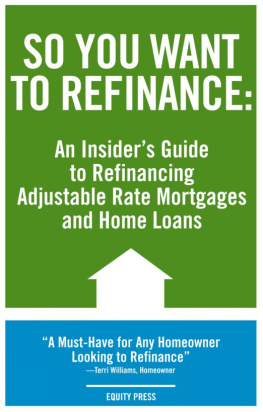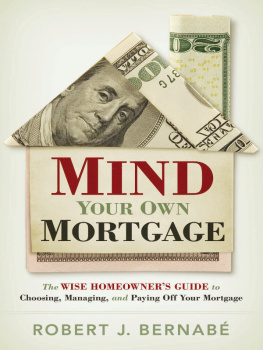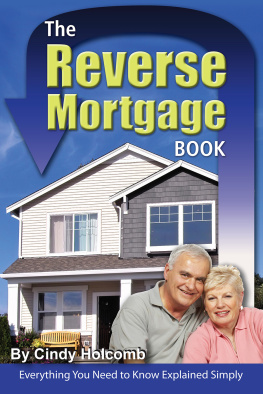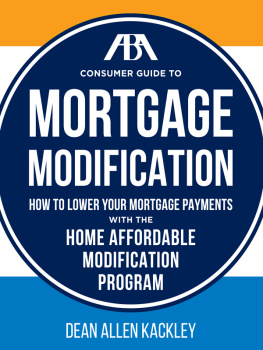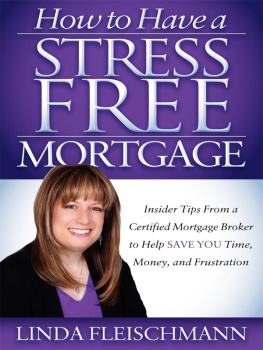SO,
You Want to RefinanceYour Home Loan?
Kristina Benson
Copyright 2006 EquityPress
Smashwords Edition
Smashwords Edition,License Notes:
This ebook is licensedfor your personal enjoyment only. This ebook may not be re-sold orgiven away to other people. If you would like to share this bookwith another person, please purchase an additional copy for eachrecipient. If youre reading this book and did not purchase it, orit was not purchased for your use only, then please return toSmashwords.com and purchase your own copy. Thank you for respectingthe hard work of this author.
So, you want torefinance your home loan?
ISBN1-933804-63-7
Copyright 2006Equity Press and Kristina Benson all rights reserved. No part ofthis publication may be reproduced, stored in a retrieval system,or transmitted in any form or by any means (electronic, mechanical,photocopying, recording or otherwise) without either the priorwritten permission of the publisher or a license permittingrestricted copying in the United States or abroad.
The scanning,uploading and distribution of this book via the internet or via anyother means with the permission of the publisher is illegal andpunishable by law. Please purchase only authorized electroniceditions, and do not participate in or encourage piracy ofcopyrighted materials.
CONTENTS
Chapter 1 The Industry
So, you areinterested in purchasing or refinancing? You are far from alone.According to mortgage giant Freddie Mac, U.S. households cashed outan estimated $480 billion in home equity between 2001 and 2003.This, by the way, is more than two-and-a-half times the equitycashed out from 1993-2000.
Forty-five percentof homeowners who refinanced between early 2001 and the first halfof 2002 used the refinance to take out cash, and 74 percent woundup with more years on their mortgage.
By mid 2004,Americans owed $766.2 billion on home equity loans and lines ofcredit --more than twice as much as in 1998, according to theFed.
Why did so manypeople refinance? There were a couple different reasons but one ofthem is credit card debt. In late 2005, the average Americancarried approximately $10,000 in unsecured debt.
And, anotherreason for refinancing was to get out of an adjustable ratemortgage that kept climbing ever-higher every month: between 2002and 2005, 30% of new home loans were adjustable. So between 2005and only God knows when, hundreds of thousands of Americans willneed to refinance yet again in order to have a manageable mortgagepayment.
A concise way tosummarize these statistics would be to say that Americans havedecided that their home can act as their own personal ATM machine.They are going shopping with credit cards, paying high interestrates on their purchases, getting sick of the growing balance ontheir credit cards, and paying off their debt with their equity. Toget the lowest payment possible, they often choose (or are talkedinto) adjustable rate mortgages that start low, but end up rising,and then once again, they have to refinance.
Meanwhile,balances on their homes are going up, rates are going up, and homevalue is going down. People who took out 100% LTV interest onlyadjustable 40 year loans may very well find themselves upside downon their house when the market cools completely. So basically, theywill owe more than their home is worth, have rising mortgagepayments, and have no way of paying down the principal balance ontheir homes. In the lending industry, we call people in thatsituation Completely Screwed. Doesnt that sound fun? So fun!
If you're tired ofthis cycle of refinancing only to be talked into a product thatleads you to refinance again not two years later, if you feel likeyou might be in a risky loan that will soon put you in the rank andfile with the Completely Screwed, or if you simply want to walkinto your refinance or purchase armed with knowledge to give youthe best deal possible, this book is for you.
And if your creditscore puts you in what the mortgage industry terms kindly as "sub-prime lending", this book is definitely for you. The sub-primelending industry has grown exponentially to service all of theseserial refinancers, and has escaped close regulation as a result.Inspires you with a lot of confidence, doesn't it? In SouthernCalifornia, the heart of the lending industry, there is a brokershop on every corner, teeming with ignorant 22 year old boyscalling themselves fancy titles like "loan officer" "creditmanager" "account manager" or "loan consultant." They get paidbased on how much they charge the borrower, and how large the loanamounts are. This culture of economic incentive has led to acorporate environment of mendacity and moral turpitude allaround.
Your home isprobably the biggest financial investment you have, and will everhave. And not only is it an investment, but you live in it. It isthe roof over your head. Putting yourself in a crappy loan so someschmuck loan officer can get a bonus for selling a certain productis probably not the best idea.
This book willteach everyone, but particularly the sub-prime borrower, how tonavigate the often complex and labyrinthine process of getting ahome loan. You'll learn about loan products and the real estateindustry from someone who doesnt stand to make a significantamount of money on whatever decision you make. You will learn whatsales techniques you will be confronted with, how to smell a lie,and what to do in the event that your loan gets screwed up.
In short, themoney you spend on this book could save you many thousands down theroad. It will help you to prepare for your refinance by sharingwith you techniques to improve your credit score, letting you knowwhat paperwork you can expect to need, and what kind of loan youcan realistically qualify for-pretty useful information when itcomes to making a decision about your greatest asset.
Who I am and whyshould you listen to me is probably a question youre asking. I wasa loan officer for three years, from 2003 to 2006. I worked forsub-prime broker shops and a gigantic direct lender. And beforethat, I spent three years managing the settlements of mortgagebacked products as they were traded on the bond market.
When I firststarted in the business, I was a top tier salesperson. I banged outridiculous numbers and charged exorbitantly. Managementdeliberately kept loan officers ignorant about the market, interestrates, loans, and lending laws, so I took it upon myself to learnon my own. The more I learned about the market and about theproducts I was selling, the lower my sales became. The relationshipbetween my knowledge and my income were inversely proportional andmy sales went into a gradual downhill slide.
The industry wentdownhill with me in lockstep. During the golden age of the mortgageindustry when I first started, 22 year olds were running arounddriving $100,000 cars to their $1,000,000 homes, spending cash asthough it grew on trees, behaving as if this fountain of money wasnever going to end. At the time, it was easy to sell a loan. Rateswere low, values were high, and it was gravy all day. As ratesbegan to rise and values began to taper (a trend we are stillseeing but have not even begun to feel the effects of) it becamemore and more difficult to make sales and to even create loans withbenefit.
In this potentenvironment of greed, youth, ignorance, and money, fraud anddishonesty became the rule rather than the exception. Loanofficers, management, and other players in the industry regularlyadjusted appraisals to inflate value or minimize flaws to theproperty, doctored rental agreements and bank statements toexaggerate the borrowers income, whited-out and wrote overunfavorable statistics in HOA certifications, and signed borrowersnames on official documents.
All of thesecreative approaches to doctoring files (euphemistically referred toas arts and crafts) did indeed increase the number of borrowersthat qualified for loans, however, it was still tough with the new,higher rates to benefit a borrower and lower his or her monthlypayment. Banks began to roll out interest only loans. Then fortyyear loans. Then forty year interest only loans. Then fifty yearloans. Then fifty year interest only loans. 125% loan-to-valueloans. 1.25% neg ams, 2.9% neg ams, 1.75% 40 year neg amsthere wasno limit to the risky products people would sell, and take, inorder to make a sale or hang on to a lifestyle that no longer waswithin realistic means.

